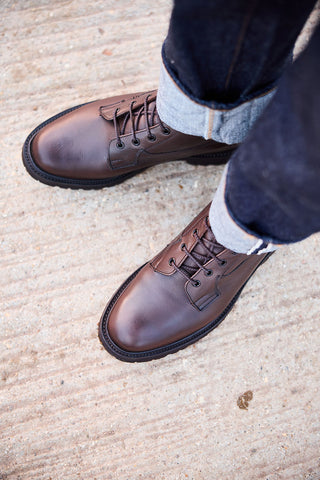While the exact history of the brogue is not quite clear, all indications suggest the earliest origins of the shoe trace back to Ireland and Scotland at some point prior to the mid-to-late 16th century. The original shoes were outdoor footwear for the country just as you find at Tricker’s today.
These early shoes - called Brogans and Cuarans - were rudimentary footwear in which the feet were wrapped in untanned leather and fixed with leather straps.
The roots of the hole decoration, an important design of the Brogues, were described only as drainage holes in the old shoes of the Highlands. It was said that hunters of Highlanders in the 16th century have made such holes in their footwear to prevent the onset of trench foot.
Scotland is full of deciduous forests; the climate is quite cold and wet so the ground would be boggy and muddy, with the holes enabling water that got into the shoe to escape so that the foot of the wearer could dry more quickly
In the case of shoes with untanned leather, the drainage holes were hidden in the hair. Any drainage holes would have been made using animal bone needles.
When the word 'brogue' came into use in the late 16th century, it was derived from the Gaelic 'brog', referring to shoes in general. It wasn't until broguing came to refer to the perforations and serrations in shoe leather that brogues became a specific style of shoe. That transition occurred somewhere in the early 20th century.
The first modern brogues were typically reserved as country footwear for men. However, the style caught on among city folk as well. Edward, the Prince of Wales deserves some credit for having made the shoes popular among the British during the 1930s.
Tricker's made a boot in 1840 that was the origin of today’s country boot. Although it was without brogue detail, the function was water resistance and had a crude hand stitched welt that you will know today as a Goodyear storm welt.
The function of dispersing water- the medallion, was mainly a decoration and Tricker's have a unique one used since the 1920’s

The serrated edges were incorporated into the shoe design in late Victorian times (Post 1870) after the Goodyear welting machines had been introduced.


